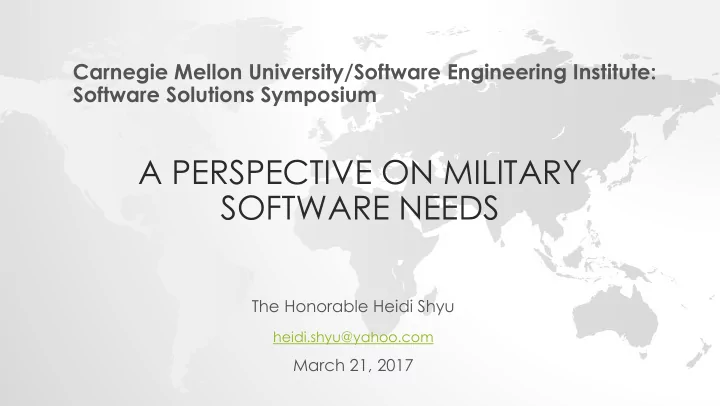

Carnegie Mellon University/Software Engineering Institute: Software Solutions Symposium A PERSPECTIVE ON MILITARY SOFTWARE NEEDS The Honorable Heidi Shyu heidi.shyu@yahoo.com March 21, 2017
AGENDA • Examples of Software Advances in 2016 • Dramatic Decrease in Cost of Computing Power • Emerging Software Capabilities Changing the Future of Warfare • Diverse Needs of Military Software Systems • Software Challenges of Military Systems • Challenges for Software Developers of Military Systems 2
EXAMPLES: EXCITING ADVANCES IN SOFTWARE IN 2016 • Tesla's Autopilot brings man with blood clot to hospital • Jan 2016: Google’s AlphaGo beats world champion at the game Go • Microsoft's AI can now understand speech better than humans • AI improves cancer diagnosis – IBM Watson detected leukemia in a woman in Japan that had been previously missed Source: TechRepublic - The 6 most exciting AI advances of 2016 3
DRAMATIC DECREASE IN COMPUTE COST 4
EMERGING SOFTWARE CAPABILITIES ARE CHANGING THE FUTURE OF WARFARE • Rapid growth of synchronized autonomous systems Perdix UAV Swarming UAVS Oct. 2016: 3 F/A-18 Super Hornets released Summer 2016: Marine swarming UAVs demo 103 Perdix self-communicating drones Electronics miniaturization combined with software advancement is creating disruptive technologies 5
EMERGING UNMANNED GROUND VEHICLES WILL DRAMATICALLY CHANGE THE GROUND FORCES Explosive Ordnance Removal ISR Situation Awareness Logistics 6 Photos: courtesy of Roboteam
EMERGING CAPABILITIES WILL FUNDAMENTALLY CHANGE TRAINING Monitor vital functions Advancements in: • Emergence of Wireless earbud augmented reality with smart trainer • Virtual reality gaming Vuzix Augmented Reality glasses • Machine learning advancement • Natural language processing 7
BIG DATA ANALYTICS IS TRANSFORMING ISR • Enabling discovery of hidden patterns, unknown correlations with unprecedented speed Graphics from enterra solutions 8
CHALLENGES • How do we leverage the explosive growth in software for military applications? • What are the software development challenges that’s unique to the military? 9
DIVERSE NEEDS OF MILITARY SOFTWARE SYSTEMS • Highly complex safety-critical mission systems: fighters, bombers, helicopters, tanks, ships, … • Command & Control systems: control satellite launch, missile launch, rocket launch, tasking UAVs, … • Communication systems: operate in challenging environment & interoperate • Radar systems: provide accurate all-weather real-time target detection & identification • Logistics systems: tracks supply & inventory, supply chain • Enterprise Resource Planning (ERPs): Military personnel & pay systems, property management, contracting … 10
SOFTWARE CHALLENGES OF MILITARY SYSTEMS • Embedded software in complex weapon systems: multiple contractors for a multitude of different systems that must interoperate in real time in challenging environment Safety critical systems Interoperability at systems-of-systems level Systems are bought at different times – different acquisition programs Security against evolving multiple attacks (cyber, physical, RF, etc.) Anti-tamper requirements • Extensive amount of independent operational testing is required 11
COMPLEXITIES OF MILITARY PROGRAMS • Can’t buy things that you don’t have a requirement for • ~2 years to formulate, develop and approve requirements • Have to plan 2 years in advance to get into the POM • Vague requirements, unattainable requirements contributing to issues down-stream • Evolving threats impact the stability of requirements • Affordability & budget availability creates “add - on” capabilities not compatible to the architecture: EP, AT • Budget instability result in changing requirements 12 AT – Anti-Tamper, EP- Electronic Protection
COMPLEXITIES OF MILITARY PROGRAMS (CONTINUED) • To initiate a program…you need a crystal ball into development, procurement, and Operational & Sustainment cost up-front • Government Must- do’s: Market survey, Analysis -of-Alternatives (AoA), Industry Day, determine contract type, affordability, not-to-exceed budget, draft RFPs, RFP, source-selection • DoD programs are highly risk-adverse with many stakeholders to satisfy 13
COMPARISON: BETWEEN COMMERCIAL VS MILITARY SOFTWARE Commercial Software Military Software Product Life Cycle Months to a couple of Decades years Software Language Evolves rapidly Must be supported for decades due to legacy processor Interoperability Limited Interoperability with legacy systems that lasts for decades Updates Frequent Infrequent Testing In-house In-house plus independent operational testing Training Current software Multiple configurations version 14
CHALLENGING SOFTWARE ENVIRONMENT FOR DEVELOPERS OF MILITARY SYSTEMS • Architecture must last for decades but software & hardware evolution is much faster…resulting in clunky patchwork • Weapon systems have much longer update cycle-time than technology life-cycle (e.g. computers refreshed every 5 yrs) • Evolving threats outpace system updates • Interoperability with legacy systems is critical • Training of operators is difficult when multiple configurations exists in operation • Trust in system, encryption, secure data, lineage of data 15
SOFTWARE CAPABILITIES NEEDED • Rapid transformation of multiple legacy systems into intuitive, ease-of-use applications • Rapid transformation of training materials and logistics manuals into ease-of-use apps • Rapid determination of “trusted” systems • Examples of needed capabilities: • Real-time integration of multi-modal, multi-functional, multi-sensor capabilities to enable automated detection, discrimination, identification and targeting • Higher order human-machine interface enabling communication thru gesture, voice, etc. 16
EXAMPLES OF SOFTWARE SOLUTIONS NEEDED • Flexible, modular architecture that enables rapid add-on • Self-checking, self-testing modular code • Assurance of trusted code • Intuitive, easy-to-use software applications • Automated transformation of trusted assured code in higher level language to lower-level language 17
QUESTIONS? Curtesy of Sean Heritage 18
Recommend
More recommend